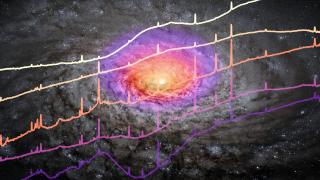Bibcode
Coloma Puga, Miguel; Balmaverde, Barbara; Capetti, Alessandro; Massaro, Francesco; Ramos Almeida, Cristina; Miley, George; Gilli, Roberto; Marconi, Alessandro
Referencia bibliográfica
The Astrophysical Journal
Fecha de publicación:
12
2023
Revista
Número de citas
4
Número de citas referidas
4
Descripción
Spatially resolved observations of active galactic nuclei (AGN) host galaxies undergoing feedback processes are one of the most relevant avenues through which galactic evolution can be studied, given the long-lasting effects AGN feedback has on gas reservoirs, star formation, and AGN environments at all scales. Within this context, we report results from Very Large Telescope/MUSE integral field optical spectroscopy of TN J1049-1258, one of the most powerful radio sources known, at a redshift of 3.7. We detected extended (~18 kpc) Lyα emission, spatially aligned with the radio axis, redshifted by 2250 ± 60 km s-1 with respect to the host galaxy systemic velocity, and cospatial with UV continuum emission. This Lyα emission could arise from a companion galaxy, although there are arguments against this interpretation. Alternatively, it might correspond to an outflow of ionized gas stemming from the radio galaxy. The outflow would be the highest redshift spatially resolved ionized outflow to date. The enormous amount of energy injected, however, appears to be unable to quench the host galaxy's prodigious star formation, occurring at a rate of ~4500 M ⊙yr-1, estimated using its far-infrared luminosity. Within the field, we also found two companion galaxies at projected distances of ~25 and ~60 kpc from the host, which suggests the host galaxy is harbored within a protocluster.
Proyectos relacionados

Actividad Nuclear en Galaxias: una Perspectiva 3D del Núcleo y su Entorno
Nuestro proyecto puede dividirse en dos líneas principales de investigación. En primer lugar, el estudio de los vientos producidos por cuásares luminosos oscurecidos y del impacto que estos tienen en sus galaxias anfitrionas (retroalimentación del AGN). Para ello hemos obtenido observaciones en el óptico e infrarrojo cercano con el Gran Telescopio
Cristina
Ramos Almeida